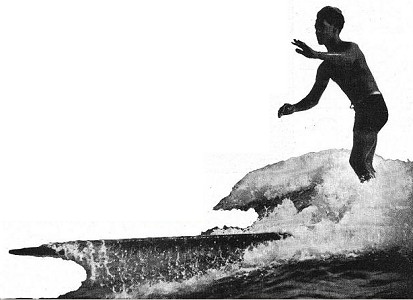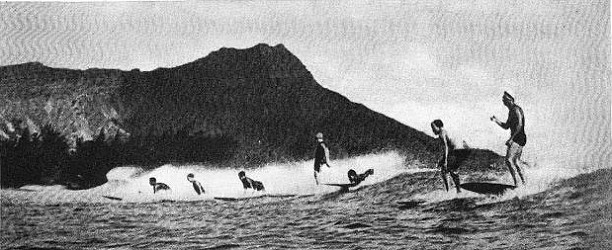 |
surfresearch.com.au
baker : ride 'em beach boy, 1933 |
| home | catalogue | history | references | appendix |
|
www.google.com.au/books
| Page 21
A
few helpful hints on the fascinating
|

|
The clearest illustration
is for the surf-riding beginner to picture a low mountain-ridge of water
with a flat board sliding downhill on the forward slope.
Next, he must
picture this ridge of water as being set in motion tward shore.
Of course when
the ocean wave moves it is not the same collection of water racing along
all the time, but a driving force which travels under the surface, and
which is constantly raising up a new ridge with new water.
When a piece
of rope is given a flip at one end a wave travels to the other end, and
exactly the same principle applies to ocean waves.
Such a wave is
always rebuilding itself as it travels in to the beach; a new wave every
foot of the way until it finally flattens out and dies on the shore.
A surf-board
actually does two things at once:
It slides down
the shoreward slope of the wave, and as this wave is constantly re-forming,
it at the same time is being swept in to shore, still sliding down a slope
which literally has no end.
As it slides
down the hill, the hill itself moves so fast that the board never stops
sliding until the hill flattens out.
Thus until the
board loses momentum at that point where it capsizes, the surf rider is
in the miraculous position of dashing along at express train speed with
the crest of a big wave roaring at his heels - and take my word for it,
this can be plenty fast enough to give a real impression of flying!
He is all by
himself just as in an air glider; there is no mechanical speeding over
the water which can compare to it for quick action and excitement.
Another thing
a surf rider fixes clearly in his mind is that a real riding surf-board
must not be confused with those highly painted, light, toy boards usually
sold in sporting goods stores.
These contraptions
are only intended for lazy folk, poor swimmers, or children to paddle aroiund
on.
They are neither
long enough enough nor stable enough for real surf-riding.
For boys up to
twelve or fourteen, a riding surf-board should be around seven feet long,
two and a half or so inches thick, and around twenty inches wide.
For older boys
and young men it will be close to ten feet long, the same thickness, and
slightly wider.
Nearly every
swimming location has a local man who can make a good board for you, and
redwood is the best American material available..
Originally, Hawaiian
koa wood, or native mahogany, was used, and a board weighed a hundred
pounds.
Redwood is now
generally used in Hawaii, being thirty or forty pounds lighter per board,
buoyant, and easier to handle.
The front end
of the board is rounded a good deal like an ironing board, and slightly
rounded underneath like the shallow underbelly of a boat, tapered slightly
streamline towards the back end.
The upper part
of the front end is also rounded up to a ...
(Continued
on page 44)
 |
... fairly thin edge, on a fairly long slant, so that it will rise up and skim the surface when paddling, or riding waves, and prevent "diving."
The first thing
Aa surf rider learns is to handle the board in fairly smooth water before
he tries to paddle it out through breaking waves, particually if the breakers
are running high.
To navigate it,
he lies on his face with feet together straight out behind him on
the board; weight enough behind the balance center so so it will not dive
when paddling along.
he drives it
ahead by using both hands at the same time, just as the blades of canoe
paddles would work if if he and another paddler were sitting side by side,
both nstriking at once.
He can use his
right foot or left foot to steer.
It is like steering
a sled with his foot; only this time he has water and not snow to drag
the toe in.
After he learns
to handle the board easily, and can steer it well, then he can head out
where the largest waves are breaking.
The best kind
of beach for surf-riding is naturally one where where the waves start to
break some distance offshore, in order to give as long a ride as possible.
If he gets tangled
with a breaking wave on the way out, and finds he cannot hang onto the
hucking board, the only thing for him to do is to let it go and dive
clear, calling a courtesy warning to anyone dangerously close between
him and the beach, just as he would call "Fore" when playing golf.
If some swimmer
is to close to dodge, he may get a hard rap on the head.
Once he has reached
a spot just inshore of where the wave crests first begin to curl, then
comes the real test.
He lies waiting
for a big fellow, looking back over his shoulder, until all ready to go.
When he sees
the right one coming, which will break just back of him, he paddles shoreward
with all his might.
Just as a standing
man cannot catch a passing train without a shock, if he has no momentum
the wave will break right over him.
And the board,
instead of being a docile plank of wood will thrash like a windmill, besides
tiring out the rider.
A fellow needs
plenty of wind to stick with the boards for very long, anyway!
But with his board
skimming fast enough ahead of the curling wave, he must give a last burst
of of paddling speed just as it catches up to him, then, all of a sudden,
he will feel a great surge upward and forward.
It is right here
that he gets the thrill which only surf riders know, and if he really has
"caught" his wave he will start on a mad dash for the beach.
Perhaps if the
boardwas not going fast enough when the wave lifted it, he will lose the
wave after a run of only a few yards, but it is a beginning, and he won't
rest until he's mastered the trick!
The Waikiki expert
usually turns his board at a slight angle to the wave slope the the second
it picks him up, to gain speed at the start of the ride, but this knack
comes withlater pracice.
The next thing
for the rider to learn is to come in kneeling, and as soon as possible
after really catching the wave, to straighten up to his knees, still grasping
the sides of the board.
he must be very
careful to keep just back of the balance center still (?), for a diving
board is always a problem in rough water.
Once this is
mastered, he then learns to come in on one knee, or crouching on his heels.
The final and
finishing step is to be able to rise to his feetfromthis kneeling or crouching
position, and ride in standing up.
Hawkshaw, champion
trick rider of Hawaii, comes inon his head, carrying someone on his shoulders
, on one foot, but why is it not one boy in a hundred here in the states
can ride a board standing up?
It is simply
because they have been unwilling to to learn these first few principles
of the sport before trying to ride!
The finest riding
surf in the world is off Waikiki, with its long Pacific rollers breaking
far offshore on the reef.
But shorter thrills
are possible all along the Atlantic and Gulf of mexico Seaboard, on the
Great lakes - in fact wherever there is a sand beach with fairly large
waves breaking fairly well out.
Bemuda, Nassau,
havanna - and especially california - have good surf and temperate water
all year round.
These shorter,
choppier waves may take more care to catch mand ride, but they are quite
fast.
Like skating,
the surf rider takes many an exciting spill, the, before he realizes the
good news, he's got it!
That first ride
is a thrill he will remember all his life.
The beginner
must remember that no one ever learned to ride the boards in a day or two.
It takes practice.
The tale goes
that Jack London mastered the the big Pacific combers in three weeks, but
plugged at it day in and day out in spite of continual spills and painful
sunburn.
To this day the
kahunna (?) - or old-timer in Hawaii - will boast of London's dogged persistance,
as a andhihiui (?), or newcomer.
His record still
stands there, the best of all time.
 |
Published by the Boy Scouts of America July 1933, Vol. 23, No. 7. |

| home | catalogue | history | references | appendix |